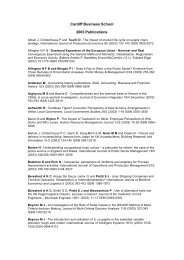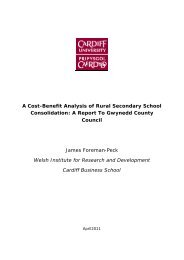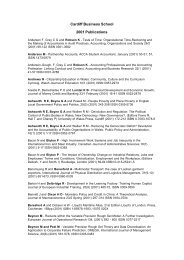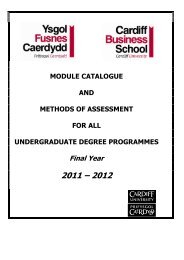Revisiting the Great Moderation using the Method of Indirect Inference
Revisiting the Great Moderation using the Method of Indirect Inference
Revisiting the Great Moderation using the Method of Indirect Inference
Create successful ePaper yourself
Turn your PDF publications into a flip-book with our unique Google optimized e-Paper software.
model. An auxiliary time series model is <strong>the</strong>n tted to each set <strong>of</strong> data and <strong>the</strong> sampling<br />
distribution <strong>of</strong> <strong>the</strong> coecients <strong>of</strong> <strong>the</strong> auxiliary time series model is obtained from <strong>the</strong>se<br />
estimates <strong>of</strong> <strong>the</strong> auxiliary model. A Wald statistic is computed to determine whe<strong>the</strong>r<br />
functions <strong>of</strong> <strong>the</strong> parameters <strong>of</strong> <strong>the</strong> time series model estimated on <strong>the</strong> actual data lie in<br />
some condence interval implied by this sampling distribution.<br />
Following Minford, Theodoridis and Meenagh (2009) we take a VAR(1) for <strong>the</strong> three<br />
macro variables (interest rate, output gap and ination) as <strong>the</strong> appropriate auxiliary<br />
model and treat as <strong>the</strong> descriptors <strong>of</strong> <strong>the</strong> data <strong>the</strong> VAR coecients and <strong>the</strong> variances<br />
<strong>of</strong> <strong>the</strong>se variables. The Wald statistic is computed from <strong>the</strong>se 8 . Thus eectively we are<br />
testing whe<strong>the</strong>r <strong>the</strong> observed dynamics and volatility <strong>of</strong> <strong>the</strong> chosen variables are explained<br />
by <strong>the</strong> simulated joint distribution <strong>of</strong> <strong>the</strong>se at a given condence level. The Wald statistic<br />
is given by:<br />
X1<br />
( ) 0 ( ) (6)<br />
()<br />
<strong>the</strong> squared `Mahalanobis distance', where is <strong>the</strong> vector <strong>of</strong> VAR estimates <strong>of</strong> <strong>the</strong> chosen<br />
descriptors yielded in each simulation, with and P ()<br />
representing <strong>the</strong> corresponding<br />
sample means and variance-covariance matrix <strong>of</strong> <strong>the</strong>se calculated across simulations,<br />
respectively 9 .<br />
Figure 2 illustrates <strong>the</strong> whole testing procedure. While panel A <strong>of</strong> <strong>the</strong> gure summarises<br />
<strong>the</strong> main steps just described, <strong>the</strong> `mountain-shaped' diagram in <strong>the</strong> second panel<br />
gives an example <strong>of</strong> how <strong>the</strong> `reality' is compared to model predictions <strong>using</strong> <strong>the</strong> Wald<br />
8 Note that <strong>the</strong> VAR impulse response functions, <strong>the</strong> co-variances, as well as <strong>the</strong> auto/cross correlations<br />
<strong>of</strong> <strong>the</strong> left-hand-side variables will all be implicitly examined when <strong>the</strong> VAR coecient matrix is<br />
considered, since <strong>the</strong> former are functions <strong>of</strong> <strong>the</strong> latter.<br />
9 Smith (1993), for his demonstration <strong>of</strong> model estimation, originally used VAR(2) as <strong>the</strong> auxiliary<br />
model. His VAR included <strong>the</strong> logged output and <strong>the</strong> logged investment and he tried to maximize <strong>the</strong><br />
model's capacity in tting <strong>the</strong> dynamic relation between <strong>the</strong>se. To this end he included <strong>the</strong> ten VAR<br />
coecients (including two constants) in his vector <strong>of</strong> data descriptors. Here, since a VAR(1) is chosen<br />
to provide a parsimonious description <strong>of</strong> <strong>the</strong> data and <strong>the</strong> models are tested against <strong>the</strong>ir capacity in<br />
tting <strong>the</strong> data's dynamic relations and size, <strong>the</strong> vector <strong>of</strong> chosen data descriptors includes nine VAR(1)<br />
coecients and three data variances. No constant is included since <strong>the</strong> data are demeaned and detrended.<br />
In <strong>the</strong> Supporting Annex we show our results that follow are robust to <strong>the</strong> choice <strong>of</strong> VAR: it turns<br />
out that <strong>using</strong> a VAR <strong>of</strong> higher orders, though streng<strong>the</strong>ning <strong>the</strong> test's rejection power, will not cause<br />
change in <strong>the</strong> ranking between <strong>the</strong> models.<br />
15








